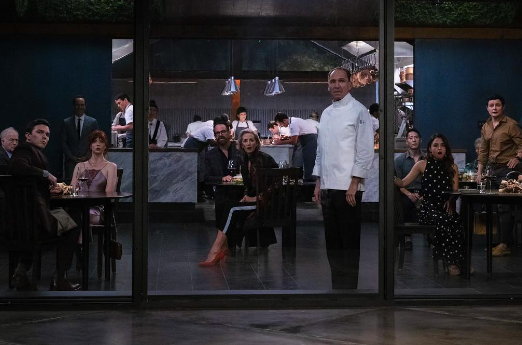The Menu: a recipe to success

Photo provided by: Searchlight Pictures
According to thefilmik.com, The Menu premiered in 3100 theaters on its first day, making over $3.6 million.
November 28, 2022
Released to theaters on Nov. 18, “The Menu” quickly became a must-watch for movie goers across the country. Including excellent performances by actress Anya Taylor-Joy, who played Margot, and Ralph Fiennes, as Chef Slowjk, accompanied by fantasmal cinematography and scenes that kept viewers on the edge of their seats, “The Menu” rightfully earned its rating of 88% by Rotten Tomatoes. However, beneath the many layers that made the film great, is a hidden deeper meaning that made “The Menu” exquisite.
While watching the film in a theater, I could not help but feel lost as to what the point of the movie was. Yes, I was enthralled by the scenes that were being played before me, but I felt as if there was something missing: a larger meaning. It wasn’t until Chef Slowjk proceeded to deny the guests of his restaurant bread that everything clicked into place. “The Menu” is not just a piece of entertainment, it is a brilliantly composed film that metaphorically shows the function and flaws of society through an evening at an exclusive restaurant.
Hawthorne, the restaurant in which the film takes place, consists of Chef Slowjk and his several assistants. The Chef oversees everything that takes place within the confines of his restaurant and his helpers aid in implementing his dinner regime. Being a highly regarded restaurant, all but one of the guests of Hawthorne come from affluent backgrounds. Margot, the only visitor at Hawthorne that did not come from a wealthy background, was surrounded by actors, corporate workers and food critiques. Metaphorically, Hawthorne symbolizes the government: Chef Slowjk symbolizing the head of a nation, the assistant chefs resembling government officials. The guests of the restaurant symbolize “elite” citizens that arguably have a larger hand in the government and Margot symbolizes the less affluent social classes and patriotism.
As the course of the film proceeded, Chef Slowjk’s heinous plans were slowly revealed. All the while the guests of Hawthorne, afraid to speak up, obliged to them. As the evening’s courses were served, only Margot refused to eat the divinely plated meals from Chef Slowjk. Margot was the only guest of the restaurant to stand up to the Chef and ultimately was the only one to successfully end the evening. The guests’ failure to fight the cruel actions taken by Chef Slowjk lead to their downfall and symbolizes many real life citizens’ naivety of government regimens and fear to stand up in the face of abusive powers. Margot’s character was created to rebel against and challenge Hawthorne, showing viewers of the film the importance of standing up to the higher powers of society and voicing their opinions.
“The Menu” excellently develops a theme to voice opinions, to challenge and to rebel. Without bravery to discuss diverse opinions, society will become a mayhem. The plot of “The Menu” provides both an entertaining story line as well as insight to a fictional world that can easily become reality.





